Exercise 5.1 : Solutions of Questions on Page Number : 85
Q1 : Which of the following statements are true and which are false? Give reasons for your answers.
(i) Only one line can pass through a single point.
(ii) There are an infinite number of lines which pass through two distinct points.
(iii) A terminated line can be produced indefinitely on both the sides.
(iv) If two circles are equal, then their radii are equal.
(v) In the following figure, if AB = PQ and PQ = XY, then AB = XY.
![]()
Answer :
(i) False. Since through a single point, infinite number of lines can pass. In the following figure, it can be seen that there are infinite numbers of lines passing through a single point P.
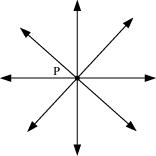
(ii) False. Since through two distinct points, only one line can pass. In the following figure, it can be seen that there is only one single line that can pass through two distinct points P and Q.
![]()
(iii) True. A terminated line can be produced indefinitely on both the sides.
Let AB be a terminated line. It can be seen that it can be produced indefinitely on both the sides.

(iv)True. If two circles are equal, then their centre and circumference will coincide and hence, the radii will also be equal.
(v) True. It is given that AB and XY are two terminated lines and both are equal to a third line PQ. Euclid’s first axiom states that things which are equal to the same thing are equal to one another. Therefore, the lines AB and XY will be equal to each other.
Q2 : Give a definition for each of the following terms. Are there other terms that need to be defined first? What are they, and how might you define them?
(i) parallel lines (ii) perpendicular lines (iii) line segment
(iv) radius of a circle (v) square
Answer :
(i) Parallel Lines
If the perpendicular distance between two lines is always constant, then these are called parallel lines. In other words, the lines which never intersect each other are called parallel lines.
To define parallel lines, we must know about point, lines, and distance between the lines and the point of intersection.
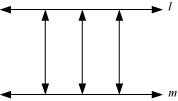
(ii) Perpendicular lines
If two lines intersect each other at 90°, then these are called perpendicular lines. We are required to define line and the angle before defining perpendicular lines.
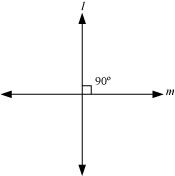
(iii) Line segment
A straight line drawn from any point to any other point is called as line segment. To define a line segment, we must know about point and line segment.
![]()
(iv) Radius of a circle
It is the distance between the centres of a circle to any point lying on the circle. To define the radius of a circle, we must know about point and circle.
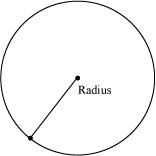
(v) Square
A square is a quadrilateral having all sides of equal length and all angles of same measure, i.e., 90°. To define square, we must know about quadrilateral, side, and angle.
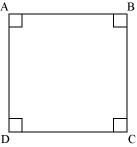
Q3 : Consider the two ‘postulates’ given below:
(i) Given any two distinct points A and B, there exists a third point C, which is between A and B.
(ii) There exists at least three points that are not on the same line.
Do these postulates contain any undefined terms? Are these postulates consistent?
Do they follow from Euclid’s postulates? Explain.
Answer :
There are various undefined terms in the given postulates.
The given postulates are consistent because they refer to two different situations. Also, it is impossible to deduce any statement that contradicts any well known axiom and postulate.
These postulates do not follow from Euclid’s postulates. They follow from the axiom, “Given two distinct points, there is a unique line that passes through them”.
Q4 : If a point C lies between two points A and B such that AC = BC, then prove that![]() . Explain by drawing the figure.
. Explain by drawing the figure.
Answer :
It is given that,
AC = BC
![]()
![]() (Equals are added on both sides) … (1)
(Equals are added on both sides) … (1)
Here, (BC + AC) coincides with AB. It is known that things which coincide with one another are equal to one another.
∴ BC + AC = AB … (2)
It is also known that things which are equal to the same thing are equal to one another. Therefore, from equations (1) and (2), we obtain
AC + AC = AB
2AC = AB
![]()
Q5 : In the above question, point C is called a mid-point of line segment AB, prove that every line segment has one and only one mid-point.
Answer :
Let there be two mid-points, C and D.
![]()
C is the mid-point of AB.
AC = CB
![]() (Equals are added on both sides) … (1)
(Equals are added on both sides) … (1)
Here, (BC + AC) coincides with AB. It is known that things which coincide with one another are equal to one another.
∴ BC + AC = AB … (2)
It is also known that things which are equal to the same thing are equal to one another. Therefore, from equations (1) and (2), we obtain
AC + AC = AB
⇒ 2AC = AB … (3)
Similarly, by taking D as the mid-point of AB, it can be proved that
2AD = AB … (4)
From equation (3) and (4), we obtain
2AC = 2AD (Things which are equal to the same thing are equal to one another.)
⇒ AC = AD (Things which are double of the same things are equal to one another.)
This is possible only when point C and D are representing a single point.
Hence, our assumption is wrong and there can be only one mid-point of a given line segment.
Q6 : In the following figure, if AC = BD, then prove that AB = CD.
![]()
Answer :
From the figure, it can be observed that
AC = AB + BC
BD = BC + CD
It is given that AC = BD
AB + BC = BC + CD (1)
According to Euclid’s axiom, when equals are subtracted from equals, the remainders are also equal.
Subtracting BC from equation (1), we obtain
AB + BC – BC = BC + CD – BC
AB = CD
Q7 : Why is Axiom 5, in the list of Euclid’s axioms, considered a ‘universal truth’? (Note that the question is not about the fifth postulate.)
Answer :
Axiom 5 states that the whole is greater than the part. This axiom is known as a universal truth because it holds true in any field, and not just in the field of mathematics. Let us take two cases – one in the field of mathematics, and one other than that.
Case I
Let t represent a whole quantity and only a, b, c are parts of it.
t = a + b + c
Clearly, t will be greater than all its parts a, b, and c.
Therefore, it is rightly said that the whole is greater than the part.
Case II
Let us consider the continent Asia. Then, let us consider a country India which belongs to Asia. India is a part of Asia and it can also be observed that Asia is greater than India. That is why we can say that the whole is greater than the part. This is true for anything in any part of the world and is thus a universal truth.
Exercise 5.2 : Solutions of Questions on Page Number : 88
Q1 : How would you rewrite Euclid’s fifth postulate so that it would be easier to understand?
Answer :
Two lines are said to be parallel if they are equidistant from one other and they do not have any point of intersection. In order to understand it easily, let us take any line l and a point P not on l. Then, by Playfair’s axiom (equivalent to the fifth postulate), there is a unique line m through P which is parallel to l.

The distance of a point from a line is the length of the perpendicular from the point to the line. Let AB be the distance of any point on m from l and CD be the distance of any point on l from m. It can be observed that AB = CD. In this way, the distance will be the same for any point on m from l and any point on l from m. Therefore, these two lines are everywhere equidistant from one another.

Q2 : Does Euclid’s fifth postulate imply the existence of parallel lines? Explain.
Answer :
Yes.
According to Euclid’s 5th postulate, when n line falls on l andm and if
![]() , producing line l and m further will meet in the side of ∠1 and ∠2 which is less than
, producing line l and m further will meet in the side of ∠1 and ∠2 which is less than
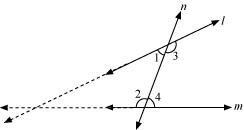
If![]()
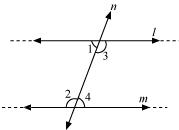
The lines l and m neither meet at the side of ∠1 and ∠2 nor at the side of ∠3 and ∠4. This means that the lines l and m will never intersect each other. Therefore, it can be said that the lines are parallel.